
Top 10 Cold Season Hardy
Share
Bountiful Blooms Farm
Amanda Eichelberger
Top 10 Cold Season Hardy
Everyone knows about summer annuals like zinnias, cosmos, and sunflowers. But there are many beautiful flowers that thrive and survive the cold temperatures. I’m always asked “how do you have flowers so early?!” and that’s because of this family of flowers called cold season hardy annuals.
Before you run off to buy seeds we need to put in a little work to set ourselves up for success. We need to figure out your first and last average frost dates. Frost dates will give us a reference point for calculating all our other critical dates.
To help keep things organized I’ve created a chart to help. Look up the following: “first/last average frost date (YOUR ZIP CODE)”. Figure out what date is 6 weeks before that first/last frost date and what date is 8 weeks before. Enter these in the chart. These are the optimal planting windows for this group of flowers. The first row of the chart is what we call your “fall planting” and the second row is the “very early spring planting".
Pro Tip:
You must know your winter hardiness zone and the winter hardiness zone of the flower you’re planting. You can search this by looking up "what's my hardiness zone (ZIP CODE)". Example: My hardiness zone is 6 and I want to grow pincushion flowers (hardiness zone 7 ) . Then, I will plant that in very early spring with protection (frost cloth). Plants with a hardiness zone 7, 8, 9 + are in early spring. 6, 5,4,3 - are fall planted.
|
Frost Dates |
6-8 Weeks Before Frost Dates |
Start Transplants 6-8 weeks before your “direct sow” seed dates |
|
First average frost date: |
Direct Sow Seeds 6 weeks before: 8 weeks before: |
Start transplants 6 weeks before: 8 weeks before: |
|
Last average frost date: |
Direct Sow Seeds 6 weeks before: 8 weeks before: |
Start transplants 6 weeks before: 8 weeks before: |
Now these dates are when you would plant seeds sown into the garden (direct sow).
If you need to start seeds for transplants, start your seeds 6-8 weeks before the direct sow dates on your chart. Figure these dates out and add them to your chart. Once you have all those dates calculated, bring out your calendar and add them. Now you know exactly when you need to plant these flowers!
Pro tip:
Prep your spring planted beds in fall that way they are ready to plant. Oftentimes very early spring is wet and you won’t be able to disturb the soil if it’s wet and muddy. Think and plan ahead. Having beds prepped and waiting you’ll be able to plant your very early spring succession right away.
Frost cloth and hoops are essential for growing many of these plants. When nighttime temps drop under 28 degrees cover plants, if the day temps are above 55 and sunny let them get sun. Row covers are great to protect against wind. If there is snow or ice, uncover plants as these are far better insulators than the covers themselves. Make sure the cloth doesn't touch plants. It will freeze onto the plants and hurt them.
- Rudbeckia (winter hardiness zone 5): ‘Triloba’, ‘Hirta’ & ‘Irish eyes’ (SI/SO)
- Scabiosa (Pincushion Flower) (winter hardiness zone 7): ‘Oxford blue’, ‘salmon’, ‘fire king’, and ‘black knight’ (SI/SO)
- Poppy (winter hardiness zone 6) : ‘Giant Bread Seed’ and ‘champagne bubbles’(SO)
- Strawflower (winter hardiness zone 8):
- Feverfew (winter hardiness zone 5): ‘Single’ and ‘sunny ball’ (SI)
- Snapdragons (winter hardiness zone 4 -varieties vary) : ‘madame butterfly’, ‘rocket’, ‘chantilly’ and ‘potomac’ (SI)
- Sweet William (winter hardiness zone 5): ‘Amazon series’ and ‘Sweet series’ (SI)
- Sweetpeas (winter hardiness zone 7): ‘spencer series’, ‘high scent’ and ‘royal mix’ (SI/SO)
- Nigella (Love-in-a-Mist) (winter hardiness zone 6) : ‘Albion Series, ‘Miss Jekyll’ and ‘Persian Series’ (SI/SO)
- Yarrow (winter hardiness zone 4): ‘Colorado Sunset’ and ‘Summer Berries’ (SI)
Key: (SI-Start inside + SO-Start Outside)
